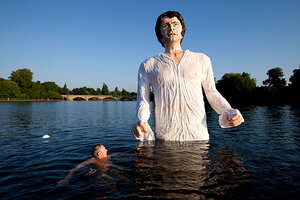English soap opera turns 200: Pride and Prejudice still resonates today
Masquerade ball opens nine-day festival in Bath celebrating bicentennial of Jane Austen’s novel.

A swimmer approaches a statue meant to depict actor Colin Firth performing as Mr. Darcy, a character in Jane Austen's novel 'Pride and Prejudice' at the Serpentine Lake, Hyde Park, London, July 8, 2013.
David Parry/AP/File
London
Jane Austen’s "Pride and Prejudice," a favorite read for generations of romance lovers, turns 200 years old this year. The novel, a powerful story about love, but also about English snobbery, manipulation, human weakness, and poverty, has earned iconic status since first being published in 1813.
Yes, the Downton Abbey mini-series with actress Maggie Smith may be the current rage in the US. But beneath those costume dramas so popular on American public television lie a British sensibility forged by works like "Pride and Prejudice," which has sold 20 million copies and been adapted countless times on film, TV, and stage.
The intelligence and manners of the novel’s main character, Elizabeth Bennett, recently played by Keira Knightley on the silver screen, and her ability to outmaneuver circumstances, was a harbinger of a modern female sensibility – recognized and understood by women across the globe.
Fans of the novel in the UK have hosted a number of bicentennial celebrations which culminate this weekend in a nine-day festival in Bath where Ms. Austen lived for five years and where she is regarded as a daughter of the city.
The festival includes a range of "Pride and Prejudice" recitals, talks, lessons in etiquette, Regency-period fashion shows, and a masked ball complete with tight-fitting breeches for the men and bonnets for the ladies.
But what is it about Austen and "Pride and Prejudice" – the book originally titled “First Impressions” and published for about $200 – that have such enduring appeal?
Ann Channon at Jane Austen’s House Museum in Chawton, Hampshire, where she lived from 1809 until just before her death in 1817, says it was her powers of observation which manifested itself in the book that helped lay the blueprint for future romantic novels.
“There’s everybody in the book – good, bad, indifferent, loveable, and hate-able. You can recognize your own traits and other people’s in 'Pride and Prejudice,'” Ms. Channon says. “The book was also ground-breaking because she made Elizabeth Bennet a heroine by standing up to a powerful, landed gentry figure like Darcy which was quite radical for the time.”
Channon says "Pride and Prejudice" gifts like bookmarks with “I love Mr. Darcy” and quotes by Bennet outsold other Austen book-related products in the museum shop by four to one.
“We sell her books in more than 35 different languages and have people visiting from around the world, yesterday from Azerbaijan,” Channon says. “She is undoubtedly the greatest female English author.”
Along with the bicentennial festivities in Bath, there have been open-air productions, balls, visits to stately homes associated with Austen’s family, film sites, and, in two weeks, a convention by the Jane Austen Society of North America in Minneapolis.
The Bank of England recently announced that Austen will appear on the new, synthetic £10 note to be issued in 2017.
Janet Todd, president of Lucy Cavendish College at Cambridge University says "Pride and Prejudice" has earned “iconic” status.
“It’s the first book in English literature that captures the romance that appeals to women. It’s Cinderella stuff – a girl with moderate beauty and means who captures the man with the great estate,” Ms. Todd says. “It has become an iconic book helped by the various films and Colin Firth and a wet shirt. I don’t necessarily think it’s the best written or most complex of her [Austen’s] works. But it’s a bit like the Mona Lisa which probably isn’t [Leonardo] Da Vinci’s best work, [even though] it’s become culturally iconic.”
Jennie Batchelor, who is reader in 18th-Century Studies and co-director of the Centre for Studies in the Long Eighteenth Century at Kent University, first picked up the book at age 12 and has read it nearly 40 times. She says other than the love story, "Pride and Prejudice" is notable for tapping into romantic ideas of England.
“It’s witty, ironic, and with strong characters, but it also gives an inaccurate view of England, with manners, politeness, and social order important elements,” Ms. Batchelor says. “It does give a blinkered view of the country. I love the book and I always find something new in it each time I read it but it’s not my favorite [Austen novel]...[Austen] matured as a writer and got better but the book has become a global brand.”
(The original headline of this story incorrectly described the novel as "Victorian." The book was in fact published in the Georgian era).

